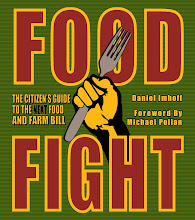Personally, I think outrage is the only sane response to the bill passed in May after nearly two years of deliberations and public input. The tag team of the corporate agribusiness lobby in cahoots with the hunger and food stamp lobby fought long and hard to ensure that the Food, Conservation, and Energy Act of 2008 remains a lot like the Food, Security, and Rural Energy Act of 2002. Sure there are some much needed programs included in the bill. But the payouts to millionaire agribusiness actually increased this time.
The skinny (or the fat, as it were).
The 2008 Farm Bill contains over $300 billion in programs that last through 2012. Over two-thirds of that budget will go to Nutrition programs, food stamps, hunger assistance, and so on. While that may seem like a lot, it was high time for the $1 per meal Food Stamp allotments of previous farm bills to be increased. A record 28 million Americans applied for Food Stamps in 2008 as a result of rising food and fuel costs and the slumping economy.
The show of hands.
The show of hands.
The bill was passed by whopping margins in the House (306-110) and Senate (82-13), and President Bush’s veto was overridden by similar majorities in both legislative branches. The subtext here is that it was an election year and the Farm Bill was everyone’s chance to bring home the pork and the earmarks. In order to get the bill passed there were $400 million in tax breaks for Kentucky racehorse breeders, assistance for farmers in Alaska and Hawaii, relief for Northwest salmon fishermen, and even $400 million to purchase timberland in Montana for a Nature Conservancy reserve (Plum Creek).
The hitch.
The hitch.
Whoops, the final copy of the bill that was sent to the President’s desk was missing Title 3, the section that deals with trade matters. The Ag Committee chairmen tried to make it seem like a harmless clerical oversight.
Why the status quo?
Why the status quo?
Collin Peterson (D-MN) was the head of the House Agriculture Committee and had no intentions of working for reform. He seemed miffed at certain points in the process last year, when hard working taxpaying citizens “who know nothing about the economics of agriculture” asked for a bit of reflection and transparency on the far reaching consequences of ballooning commodity supports in a year when farmers are receiving record prices. Tom Harkin (D-IA), chair of the Senate Agriculture Committee, was supposed to stand up for reform, as was House Speaker Nancy Pelosi, who hails from the district in the world where food and sustainability issues reign supreme. Both settled for the shallow reforms they were championing without tackling the elephant in the living room—agribusiness plundering of the treasury.
Biggest Scam.
Biggest Scam.
The Average Crop Revenue Election program (ACRE) will be rolled out next year for commodity growers. A large national farm lobby called the ACRE “lucrative beyond our expectations.” If prices fall below 2007 and 2008 record levels, which most agricultural economists expect they will, or if yields decline due to unpredictable weather or other problems, commodity payments could make a joke out of the already monumental payment programs of the 2002 farm bill.
Largest taxpayer insult.
Largest taxpayer insult.
In a 600-page bill loaded with ridiculous programs, the $3.2 billion Permanent Disaster slush fund has to take the cake. The intent of this ominously titled program is to ensure payment for farmers who are growing in areas where drought and flood are almost cyclically assured at least half the time—places like North and South Dakota and Montana, where the program’s champion Max Baucchus resides. Many experts predict guaranteed income for farming on marginal soils will cause a crash in waterfowl and other imperiled species, as well as a second coming of Dust Bowl conditions.
New Player at the Table.
New Player at the Table.
Specialty Crops are farm bill speak for foods that are actually edible without being processed or fed to animals—fruits, nuts, and vegetables. They’re also recommended in numerous daily servings by the USDA nutritional guidelines. Specialty crop growers have been left out of Farm Bill negotiations for decades but successfully wrangled a few billion dollar slice of the Farm Bill pie. This effort was led by the Western Growers (who wanted to implement a scorched earth policy on specialty crop regions around the country to prevent wild nature from contaminating fruits and vegetables) and House Speaker Nancy Pelosi.
Greatest Disappointment.
Greatest Disappointment.
The failure to reduce the levels of adjusted gross income to wealthy farmers or to limit the amounts of subsidies a given enterprise can receive are possibly the biggest letdowns. A married couple can have earnings up to $1 million in off-farm income and still receive payments. A married couple with $1.5 million in on-farm income is also eligible and there is no need to shut the spigot off. Payments flow regardless.
The best played hand.
The best played hand.
The organic industry came to the table with a simple argument. Organics is now 2 percent of the market and growing rapidly. They asked for a fair share of research dollars, cost supports, and even of things like economic studies and record keeping. It worked.
Most absent constituency.
Most absent constituency.
The medical community. Over the course of the Farm Bill debate, numerous studies linked subsidies for processed foods and the confinement animal industry to the nation’s obesity crisis. The medical costs of this nutrition epidemic now exceed $120 billion annually—many times more than cost of subsidy programs. At some point, we need to value feeding people a well-balanced diet in the first place. One wonders when doctors, nutritionists, and health professionals will wake up to the importance of the farm bill, and the power of healthy food as the original preventive medicine.
Most obvious glaring need.
Most obvious glaring need.
A long-term vision that deeply discusses future need and goals is desperately lacking. This would include incentives for soil protection rather than soil erosion, as well as the promotion of regional food production capacities that include diversified crops.
Biggest stumbling block.
Biggest stumbling block.
This may be a toss-up between the glaring need for lobby reform and anti-trust enforcement and the need to separate the nutrition title out of the farm bill. As for the former, money talks. Agribusiness showered Congress with money, and they wrote the rules. As for the nutrition title, it seems that once the hunger lobbyists get the most they think they can, they are more than content to let agribusiness run roughshod over the land, rural communities, and even the country’s nutritional well-being. We need to make farming and food assistance separate conversations by negotiating food stamps and nutrition programs at the same time the budgets are made for the national school lunch program.
Where to go from here.
Where to go from here.
It’s time to begin the long march toward 2012, building alliances, developing regional food policy plans, and being prepared this time well before the gloves come off. That, and some how resurrect our only president who mustered the wherewithal to stand up to the great corporate monopolies. It’s time to bring back Teddy Roosevelt.









